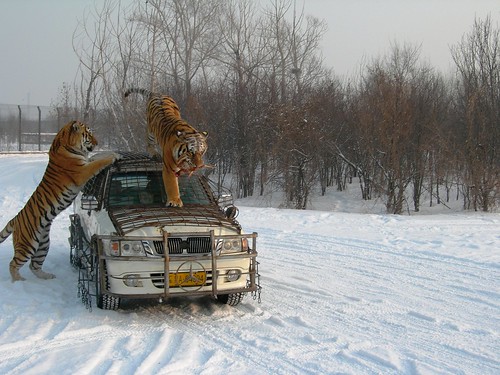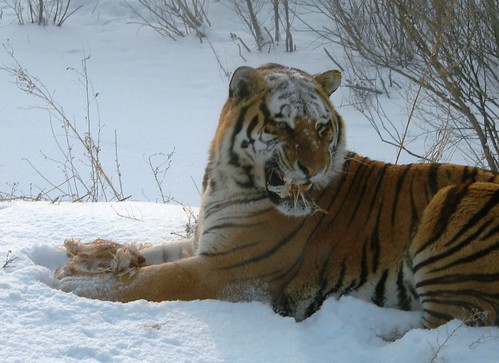The Heilongjiang Northeastern Tiger Forest Park is a breeding ground for the endangered species, which has been found to be almost genetically identical to the now-extinct Caspian tiger. The park started out with only 8 tigers, but when I visited, there were a lot of tigers roaming around. Perhaps twenty-odd tigers (the ones who had misbehaved, I presume) were pacing restlessly in cages, but most of them (there must have been over 100) were prowling about in large fields of snow and brush, surrounded by high metal fences. And boy, did they prowl.
For 10 RMB, you could buy a live chicken to be tossed to tigers by a park employee sitting in a cage-reinforced SUV. Safely inside our tour-van, we watched, mesmerized, as a tiger leaped on to the roof of the car and snatched the chicken before it even had a chance to flap its wings.

You could also buy larger animals for more money.
The arrival of the caged vehicle and the throwing of the chicken is definitely a ritual that they've become accustomed to, as tours run every hour. But even still, there was an easiness, a casualness, to the way that the tigers caught and ripped apart their "prey" that made me realize that I would really not like to a run into one of these animals in the wild.

The park also had a zoo-style array of other large cats, including African lions, a liger, cheetahs, and black leopards. I'm not really sure how these animals were surviving the snowy Harbin winter, or why they were even in Harbin in the first place. Seems like they should be relocated to a more suitable climate.
The park seemed more like a tourist venture than a scientific breeding area for an endangered species. But in the end, I think that the existence of a program to increase the Siberian tiger population, even if it's touristy and zoo-like in some aspects, is better than nothing at all. What the park managers are planning to do with a large number of majestic but dangerous animals who are ill-adapted to survive in the wild remains a question. Worth my 90 RMB? I think so.
Margs this seems like a weird soupy mixture of artificial/weird/wild in ways I don't know how to respond. I agree better this than nothing, but it's be great to see these creatures in the real wild without endless supplies of chickens and automobile scratch posts....I assume you took these pictures? They are magnificent moments...I have such respect for these big meows! <3megh
ReplyDelete